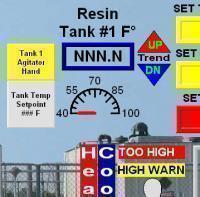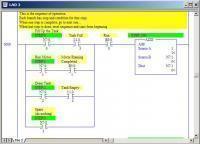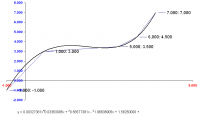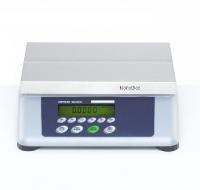86 files
-
TShark Triggering
By Ken Roach
This is a writeup and two examples of using a ControlLogix or an SLC-5/05 to trigger the TShark IP analysis program on a PC using the SerialKeys feature of Windows.
I am placing this file on the MrPLC website both for sharing and so I can find it again when I need it !
1153 downloads
Updated
-
TRUNCATE IEEE754 FLOAT
By TConnolly
Sometimes is necessary to truncate (remove the fraction) or round a floating point number that is outside the range of -32678 to +32767 - making it impossible to use a MOV to an integer to make the conversion.
This is a program I worte that shows how to perform a truncation directly on the floating point number by copyng the 32 bit pattern of the float and then determining which bits of the mantissa to keep and clearing all the rest. It includes three subroutines two of which show two different methods of truncating the float and a third which rounds the float to the nearest whole float.
An understanding of the IEEE-754 float format is helpful in understanding how this program works but its not necessary to use it.
1674 downloads
Updated
-
Updated
-
Updated
-
Toggle Bit
By Chris Elston
Want to have a bit that are low in 0.5 seconds ond high in 0.5 seconds and this in only two rungs. This is for verison 10 of RsLogix 5000 but if you don't have that version here it is. Make one timer named Timer Make one bit named Toggle. RUNG 0 -
2747 downloads
Updated
-
Toggle Bit
By Chris Elston
Want to have a bit that are low in 0.5 seconds ond high in 0.5 seconds and this in only two rungs. This is for verison 10 of RsLogix 5000 but if you don't have that version here it is. Make one timer named Timer Make one bit named Toggle. RUNG 0 -
2635 downloads
Updated
-
Temperature Trend Direction Flag
By Chris Elston
Operator wanted an easy way to tell if temperature was rising or falling in the tank. So without having to setup a full blown trend chart I came up with the "trend flag". If the flag or integer "Tank_1_Resin_Temp_Trend" was equal to "1" then the temperature is rising. If the flag is "0" then the temperature is falling. Easy fix with one rung.
2438 downloads
Updated
-
Updated
-
Solve system whit Gauss-Jordan
This Add-On Instruction Solve the equations System
whit Gauss-Jordan Reduction
In the matrix A [ i , j ] put the System of N-Equation.
In the vector b put the solutions
§§§§§§§§§§§§§§§§§§§§§§§§§§§§§§§§§§§§§§§§§§§§§§§§§
Example 1: Linear System 3 equation (X,Y,Z)
3 X + 2 Y - Z = 10
- X + Y + Z = -2
2 X - Y + 2 Z = -6
| 3 | | 2 | | -1 | | 10 |
X | -1 | + Y | 1 | + Z | 1 | = | -2 |
| 2 | | -1 | | 2 | | -6 |
Matrix A :=
Matrix[1,1]= 3 ; Matrix[1,2]= 2 ; Matrix[1,3]= -1
Matrix[2,1]= -1 ; Matrix[2,2]= 1 ; Matrix[2,3]= -2
Matrix[3,1]= 2 ; Matrix[3,2]= -1 ; Matrix[3,3]= -6
Vector b:=
Vector[1] =10 ; Vector[2] = -2 ; Vector[3] = -6 ;
Solution :=
Solution [1] := 1.0 ; Solution [2] := 2.0 ; Solution [3] := -3.0 ;
X = 1 ; Y = 2 ; Z = -3
§§§§§§§§§§§§§§§§§§§§§§§§§§§§§§§§§§§§§§§§§§§§§§§§§§§§§§§§§§§§§§§§§§
Example 2: Linear System 5 equation for resolve Polynomial 4th grade
exampl. Polynomial whit 5 points:
P0(-1,-1) ;
P1( 1, 3) ;
P2( 5, 3.5) ;
P3( 6, 4.5) ;
P4( 7, 7) ;
Write in the Matrix A [ i, j ]
Matrix A :=
Matrix[1,1]= (-1)^4 ; Matrix[1,2]= (-1)^3 ; Matrix[1,3]= (-1)^2 ; Matrix[1,4]= (-1) ; Matrix[1,5]=1;
Matrix[2,1]= (1)^4 ; Matrix[2,2]= (1)^3 ; Matrix[2,3]= (1)^2 ; Matrix[2,4]= (1) ; Matrix[2,5]=1;
Matrix[3,1]= (5)^4 ; Matrix[3,2]= (5)^3 ; Matrix[3,3]= (5)^2 ; Matrix[3,4]= (5) ; Matrix[3,5]=1;
Matrix[4,1]= (6)^4 ; Matrix[4,2]= (6)^3 ; Matrix[4,3]= (6)^2 ; Matrix[4,4]= (6) ; Matrix[4,5]=1;
Matrix[5,1]= (7)^4 ; Matrix[5,2]= (7)^3 ; Matrix[5,3]= (7)^2 ; Matrix[5,4]= (7) ; Matrix[5,5]=1;
Write in the Vector [ ]
Vector b:=
Vector[1] = -1 ; Vector[2] = 3 ; Vector[3] = 3.5 ; Vector[4] = 4.5 ; Vector[5] = 7
Solutions :=
Solution [1] := 3.27380234e-003 ; Solution [2] := 0.03363105;
Solution [3] := -0.56577414 ; Solution [4] := 1.966369 ;
Solution [5] := 1.5625005
§§§§§§§§§§§§§§§§§§§§§§§§§§§§§§§§§§§§§§§§§§§§§§§§§§§§§§§§§§§§§§§§§§
Example 3: Linear System 6 equation for resolve Polynomial 5th grade
example. Mototion Interpolation whit Polynomial
whit 2 Points :
P0 (Time0, Position 0) Start point whit (Velocity 0, Acceleration 0)
P1 (Time1, Position 1) End point whit (Velocity 1, Acceleration 1)
Write in the Matrix A [ i, j ]
Matrix A :=
X0 = time0 ; X1 = time1
Row1 X0 ^5 + X0 ^4 + X0 ^3 + X0 ^2 + X0 + 1 (Position P0)
Row2 5 * X0 ^4 + 4 * X0 ^3 + 3 * X0 ^2 + 2 * X0 + 1 + 0 (Velocity P0)
Row3 20 * X0 ^3 + 12 * X0 ^2 + 6 * X0 + 2 + 0 + 0 (Acceleration P0)
Row4 X1 ^5 + X1 ^4 + X1 ^3 + X1 ^2 + X1 + 1 (Position P1)
Row5 5 * X1 ^4 + 4 * X1 ^3 + 3 * X1 ^2 + 2 * X1 + 1 + 0 (Velocity P1)
Row6 20 * X1 ^3 + 12 * X1 ^2 + 6 * X1 + 2 + 0 + 0 (Acceleration P1)
Vector b:=
Vector[1] = Position P0 ; Vector[2] = Velocity P0 ; Vector[3] = Acceleration P0 ;
Vector[4] = Position P1 ; Vector[5] = Velocity P1 ; Vector[6] = Acceleration P1 ;
Interpolation Polynomial Position :=
Position := s1* t^5 + s2* t^4 +s3* t^3 + s4* t^2 + s5* t + s6;
2087 downloads
Submitted
-
Small Pumping Station Example using Subroutines
By Guest
The actual application is very easy but I have posted it as a nice tidy
example of using subroutines and organising datatables to make the best use
of them. The benefit of this technique is that programs have a very clear
structure and it becom
7295 downloads
Updated
-
SLC500 Measure Resistance
By panic mode
This was one of my early projects. I had to measure resistance in pretty
wide range on a delicate circuit (subject was changing value and in range
from few ohms to more than 1MOhm).
Normally I would have used something like RTD transducer but I just couldn't
find anything suitable for that range (every transducer I could find was
stopping at some 8 or 10k i needed at least 100x more).
The time was running out so I had to put something together and fast.
This is it. Initially this circuit was using dedicated regulated
low voltage power supply but since I had spare analog input(s)
I replaced that power supply with voltage divider (Panel had existing
24VDC power supply) and simply had to monitor that voltage because
it was not regulated any more (the 24VDC was regulated but the output
of divider was changing depending on test conditions).
Although we like to avoid custom designs this turned out to be so simple
cheap easy to use and worked extremly well. It is so small that there
was no need for PCB two resistors ware connected directly to terminals.
Accuracy off course could not match the 8-digits of precission benchtop
multimeter but it was on pair with my multimeters which is more
than I could ask for. I didn't test it for significant ambient changes
(temperature and humitity).
There are several ways to do the math for this and in fact used aproach is
not the simplest or most efficient. But it is good example on how simple
DC circuits knowledge and very basic match can be used in practice.
R1 and R2 are not critical and don't need to be accurate either (just need to
produce voltage that fits selected range for used input card.
It is robust enough. In fact I was surprised to see results when R1/R2 ratio
was adjusted to produce only 1 Volt (what kind of ADC they have in their cards?).
----- EDIT ----
Download Link currently doesn't work so just click on
"Click here for to join forum discussion"
18803 downloads
Updated
-
SLC to a Mettler Toledo BBK Scale RS-232 (thru Devicenet)
By Chris Elston
Here is a sample program that talkes to a Mettler Toledo BBK scale using a Point I/O RS232 ASC module on device net. Way powerful module!
To query the scale you need to send an ASCII command:
S<CR><LF>
This is the capital "S" a carriage return then a line feed.
In the Allen Bradley SLC PLC you'll need to send special characters.
ST18:10 (see PDF file data_file.pdf page 25)
string value to printer from PLC
S^M^J
^M in Allen Bradley means = carriage return
^J in Allen Bradley means = line feed
Next you have to parse the data the scale just returned to you.
Starting at Rung 5 in the PDF read the string from the scale (through devicenet) and begin to parse out the "data".
The scale sends the PLC a string like this:
^S^JS S 0.000 lb
See ST18:0 in the data_file.pdf.
Begin to count characters to the data you need weight in the case. Then "extract" the portion of the string into another ST18:1 register.
You'll notice that the data has a decimal point in the string. Allen Bradley doesn't support "string to real" function so you'll need to extract the whole number then extract the decimal point value into two separate strings. Once you do that you can do a string to integer conversion. Once it's an integer format both the whole number and decimal place you can add the two values back together like it was before as a real type format or floating point using ladder logic to do the math.
2212 downloads
Updated
-
SLC CLOCK CHANGE FOR DAY LIGHT SAVINGS TIME
By Ken Moore
This logic will advance the system clock one hour on the first Sunday in April and retard it one hour the last Sunday in October.
After installing the day of the week counter will have to be set correctly.
2426 downloads
Updated
-
SLC ADD MANY REGISTERS AND AVERAGE THE VALUE
By Ken Moore
Example that adds 100 integers using loop logic then gets the average value of the 100 values.
Number of integers added can be modified as needed.
2705 downloads
Updated
-
Simple 48 Step Sequencer
By BobLfoot
I've seen several Sequencers but not one quite like this. The Integer Bits trigger the step and the Boolean Bitrs end the step. You add the code to make that happen.
5897 downloads
Updated
-
Save Version 2.0
By Chris Elston
Same as the Save below but with Comments on all Rungs. Save Timer Program using Indirect Addressing in 4 Rungs.
1808 downloads
Updated
-
Save
By Chris Elston
Saving x number of Timers or Data in four rungs. Example uses 12 Timers saved in N7. Then Move values from the N7's to the T4 Preset. The N7 values being moved into the T4 Preset can be different from were the T4 values were moved into. Not valid for
1381 downloads
Updated
-
Sartorius SBI protocol parse
By Ken Roach
RSLogix 5000 v13 example for parsing a data string from a Sartorius-brand scale.
This is in response to Rodger Furey's inquiry in this thread:
http://forum.mrplc.com/index.php?showtopic=3919''>http://forum.mrplc.com/index.php?showtopic=3919' target='_blank'>http://forum.mrplc.
1264 downloads
Updated
-
Sample PLC Intergration with a Mold Machine
By Chris Elston
This zip file contains a complete Allen Bradley PLC file and Panel View application of a mold machine and automation intergration.
5779 downloads
Updated
-
RsLogix 500 SQC SQO Basic Sequencer
By TimWilborne
Here is the basic sequencer I use for RsLogix500 products. Let me know if any of it is not clear. I simplified an existing program just to show the sequencer parts
8335 downloads
Updated
-
RND LINEAR CONGRUENTIAL GENERATOR Casual Numbers
A Linear Congruential Generator (LCG)
Represents one of the oldest and best-known pseudorandom number generator algorithms.
1365 downloads
Updated
-
Real to Fraction
Add-On Instruction Float to Fraction FTF
this Add-On convert a real to Fraction.
Add Documentation inside the file.
Good work.
1743 downloads
Updated
-
Read Monitoring Parameters from E3 with SLC-5/0x
By Ken Roach
RSLogix 500 routine to read the first 20 parameters from an E3/E3+ overload relay on DeviceNet with an SLC-500 controller and 1747-SDN. This example uses the new DeviceNet Explicit Message (DEM) instruction introduced with OS302 Series C FRN10 firmware.
The 21st parameter is also important but will almost always be part of the I/O connection so we're only reading 20 parameters which fits more snugly into a data array.
This routine only reads from one E3+ device at Node 3 on the network.
1253 downloads
Updated
-
RAMP Function Example Logic
By Chris Elston
This is a sample clipped from a bigger program. This example uses a RAMP function to control an analog card 0-5V signal to a MicroMo DC controller. What the RAMP function does in this example is very useful to control an ACCEL or DEACCEL value to your an
5698 downloads
Updated
-
Submitted





